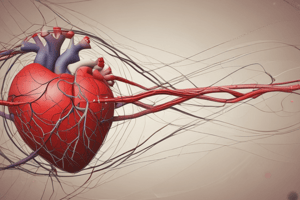Podcast
Questions and Answers
What type of information do baroreceptors primarily relay to the CNS?
What type of information do baroreceptors primarily relay to the CNS?
- Indication of vascular fullness (correct)
- Carbon dioxide elimination rates
- Oxygen levels in the blood
- Heart rate and rhythm changes
Which center in the medulla oblongata is responsible for increasing heart rate and myocardial contraction?
Which center in the medulla oblongata is responsible for increasing heart rate and myocardial contraction?
- Vasomotor center
- Cardioacceleratory center (correct)
- Cardioinhibitory center
- Respiratory center
What is the primary purpose of the baroreceptor reflex?
What is the primary purpose of the baroreceptor reflex?
- Immediate response to arterial pressure changes (correct)
- Long-term blood pressure regulation
- Enhancement of kidney function
- Maintenance of oxygen levels
Which hormone system is primarily involved in the long-term control of blood pressure?
Which hormone system is primarily involved in the long-term control of blood pressure?
What is the recommended first step in treating hypertension for patients with a blood pressure greater than 130/80?
What is the recommended first step in treating hypertension for patients with a blood pressure greater than 130/80?
How does the sympathetic nervous system respond to a decrease in blood pressure?
How does the sympathetic nervous system respond to a decrease in blood pressure?
What role do kidneys play in long-term blood pressure regulation?
What role do kidneys play in long-term blood pressure regulation?
When should dual therapy be initiated for hypertension?
When should dual therapy be initiated for hypertension?
What does the cardioinhibitory center do when activated?
What does the cardioinhibitory center do when activated?
Which of the following regulates water output and intake as part of the blood pressure control mechanisms?
Which of the following regulates water output and intake as part of the blood pressure control mechanisms?
What is the role of baroreceptors in the control of arterial pressure?
What is the role of baroreceptors in the control of arterial pressure?
Which mechanism is primarily responsible for short-term control of blood pressure?
Which mechanism is primarily responsible for short-term control of blood pressure?
What does MAP stand for in the context of blood pressure?
What does MAP stand for in the context of blood pressure?
Which of the following statements about the sensors for arterial pressure control is incorrect?
Which of the following statements about the sensors for arterial pressure control is incorrect?
What general treatment strategy is commonly recommended for managing hypertension?
What general treatment strategy is commonly recommended for managing hypertension?
Which of the following accurately describes the RAAS?
Which of the following accurately describes the RAAS?
How do cardiopulmonary receptors contribute to arterial pressure control?
How do cardiopulmonary receptors contribute to arterial pressure control?
What physiological condition does hypertension refer to?
What physiological condition does hypertension refer to?
Which of the following best describes preload?
Which of the following best describes preload?
Which factor is NOT typically considered in the long-term regulation of blood pressure?
Which factor is NOT typically considered in the long-term regulation of blood pressure?
Flashcards
Major factors influencing blood pressure
Major factors influencing blood pressure
Factors like mean arterial pressure (MAP), cardiac output (CO), systemic vascular resistance (SVR), preload, and inotropy affect blood pressure.
Baroreceptor reflex
Baroreceptor reflex
A quick-acting feedback loop that regulates blood pressure by monitoring pressure changes in arteries, and then adjusts heart rate & blood vessel diameter.
Mean arterial pressure (MAP)
Mean arterial pressure (MAP)
Average blood pressure in arteries during a cardiac cycle, a major factor for long-term blood pressure control.
Arterial baroreceptors
Arterial baroreceptors
Signup and view all the flashcards
Cardiopulmonary receptors
Cardiopulmonary receptors
Signup and view all the flashcards
Arterial pressure control
Arterial pressure control
Signup and view all the flashcards
Cardiovascular system (CV System)
Cardiovascular system (CV System)
Signup and view all the flashcards
Hypertension
Hypertension
Signup and view all the flashcards
Treatment strategies for hypertension
Treatment strategies for hypertension
Signup and view all the flashcards
Baroreflex feedback loop
Baroreflex feedback loop
Signup and view all the flashcards
Baroreceptors
Baroreceptors
Signup and view all the flashcards
Medulla Oblongata
Medulla Oblongata
Signup and view all the flashcards
MAP Long-Term Control
MAP Long-Term Control
Signup and view all the flashcards
RAAS (Renin-Angiotensin-Aldosterone System)
RAAS (Renin-Angiotensin-Aldosterone System)
Signup and view all the flashcards
Sympathetic NS Response
Sympathetic NS Response
Signup and view all the flashcards
Hypertension Treatment
Hypertension Treatment
Signup and view all the flashcards
Blood Pressure Target
Blood Pressure Target
Signup and view all the flashcards
Study Notes
Lecture #31: Hypertension Physiology
- Julia Hum, PhD, Primary Course Instructor
- Course meets Monday/Wednesday/Friday, 2:00-2:50pm
- Office hours Monday/Wednesday/Friday, 11:00am-12:00pm (317B or WebEx)
- Lecture materials are from Lippincott Illustrated Reviews: Physiology 1e Wilson (Ch. 20)
L31: Learning Objectives
- Define major factors influencing blood pressure
- Differentiate sensors aiding in arterial pressure control
- Explain how cardiovascular control centers maintain arterial pressure control
- Diagram baroreceptor reflex and the RAAS
- Compare short- and long-term mechanisms for controlling blood pressure
- Diagram sympathetic nervous system and RAAS response to blood pressure changes
- Define hypertension and describe general treatment strategies
L31: "Take Home" Slide
- Arterial blood pressure is affected by cardiac output, peripheral resistance, heart rate, filling pressure, contractility, blood volume, and venous tone.
- Baroreceptor reflex is a short-term fix for changes in arterial blood pressure.
- Drop in aortic pressure triggers reflex
- Resistance vessels constrict to limit outflow
- Increased inotropy and heart rate to increase cardiac output
- Venoconstriction to increase venous return
- RAAS (Renin-Angiotensin-Aldosterone System) is a long-term fix for changes in arterial blood pressure
- Renin released from kidney afferent arterioles in response to decreased blood pressure
- Renin catalyzes Angiotensin I (Ang I) formation
- Ang I converted to Angiotensin II (Ang II) by Angiotensin-Converting Enzyme (ACE)
- Ang II stimulates aldosterone release from adrenal glands
- Aldosterone stimulates water and Na+ recovery from urine, increasing blood volume and therefore, increasing blood pressure
Major Factors Influencing Blood Pressure
- MAP: Mean Arterial Pressure
- CO: Cardiac Output
- SVR: Systemic Vascular Resistance
- Preload: Ventricular filling pressure
- Inotropy: Contractility of the myocardium
Arterial Pressure Control
- Cardiovascular system uses two pathways:
- Baroreceptor reflex (short-term):
- Sensors: Arterial baroreceptors, Cardiopulmonary receptors, and Chemoreceptors
- Integrator: Medulla oblongata's Cardiovascular Center
- Effectors: Changes in cardiac output and peripheral resistance
- Mean arterial pressure (MAP) (long-term):
- Changes in circulating blood volume by modifying renal function
- Baroreceptor reflex (short-term):
Arterial Pressure Control: Sensors
- Three main sensors:
- Arterial baroreceptors
- Cardiopulmonary receptors
- Chemoreceptors (discussed during pulmonary section)
Arterial Baroreceptors
- Bare sensory nerve endings in the aorta and carotid sinus
- Respond to changes in Mean Arterial Pressure (MAP)
- Increases in MAP stretch the nerve endings, increasing their firing rate
Cardiopulmonary Receptors
- Baroreceptors also in regions of the cardiovascular system
- Provide information on fullness indication
- Found in the walls of vena cava, pulmonary artery, vein and atria
- Relay information to CNS via vagal nerve trunk
Central Integrator: Medulla Oblongata
- Sensory afferents converge on the medulla oblongata
- Cardiovascular Center (input/output control)
- Vasomotor center
- Cardioacceleratory center - increases Heart Rate (HR) and myocardial contraction
- Cardioinhibitory center - slows HR
Baroreceptor Reflex - Short Term Fix
- MAP falls, triggering the baroreceptor reflex.
- Heart rate increases, moving blood back into the arterial system.
- Systemic vascular resistance increases
- Inotropy increases (myocardium contracts harder).
- LV preload increases.
- Venoconstriction reduces venous system capacity.
MAP: Long-term Control Pathways
- Require 24-48 hours for full effectiveness
- Pathways converge on kidneys to control vascular fullness (circulating blood volume)
- Regulate water output and intake
- Regulate Na+ levels (controls water partitioning in cells)
MAP: Long-term Control Pathways - Renin-Angiotensin-Aldosterone System (RAAS)
- Renin released from kidney afferent arterioles during decreased blood pressure.
- Renin converts angiotensinogen to angiotensin I.
- Angiotensin I converted to angiotensin II (Ang II) by ACE.
- Ang II stimulates aldosterone release.
- Aldosterone promotes Na+ and water recovery from the urine, increasing blood volume
Response of Sympathetic NS to Changes in Blood Pressure
- Sympathetic nervous system activity increases (decreased BP) or decreases (increased BP)
- Activation of different receptors that promote either vasoconstriction, increased heart rate, and increased cardiac output
Hypertension: Treatment Strategies
- Goal: reduce cardiovascular and renal morbidity and mortality
- Current recommendations
- Start monotherapy (e.g., thiazide diuretic, ACE inhibitor, ARB, or calcium channel blocker) if blood pressure (BP) is >130/80 mmHg
- Still uncontrolled: add additional medication, selecting based on adverse effects to achieve goal BP
- If BP >160/100 mmHg: dual therapy should be started
What is Hypertension?
- Blood pressure categories in adults (Current Guidelines):
- Normal: <120 and <80 mmHg
- Elevated: 120-129 and <80 mmHg
- Hypertensive Stage 1: 130-139 or ≥80-89 mmHg
- Hypertensive Stage 2: ≥140 or ≥90 mmHg
How Does Hypertension Occur?
- Most hypertension is secondary to other diseases
- 90% of patients have essential hypertension
- Known influences: family history, age, race, education, income, diet, stress
FYI: Concomitant Disease and Drug Classes in Hypertension Treatment
- Drug classes for various concomitant diseases (e.g., high coronary disease risk, diabetes, recurrent stroke, heart failure, previous myocardial infarction, chronic renal disease) are listed
Factors Tipping the Scale Towards Hypertension
- Factors that contribute to the development of hypertension are discussed.
Studying That Suits You
Use AI to generate personalized quizzes and flashcards to suit your learning preferences.





